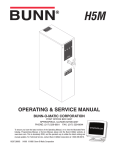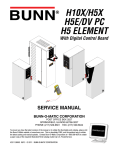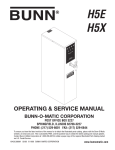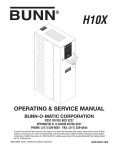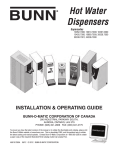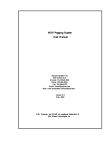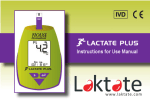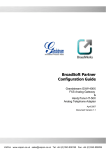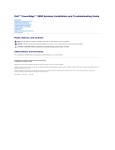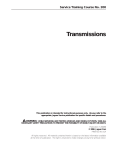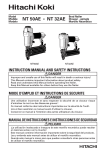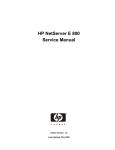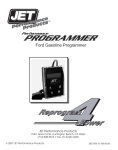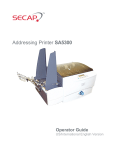Download Service Manual
Transcript
PRECISION WATER SERIES SERVICE MANUAL BUNN-O-MATIC CORPORATION POST OFFICE BOX 3227 SPRINGFIELD, ILLINOIS 62708-3227 PHONE: (217) 529-6601 FAX: (217) 529-6644 To ensure you have the latest revision of the manual or to obtain the illustrated parts catalog, please visit the Bunn-O-Matic website, at www.bunn.com. This is absolutely FREE, and the quickest way to obtain the latest catalog and manual updates. Contact Bunn-O-Matic Corporation at 1-800-286-6070 to obtain a paper copy of the required Illustrated Parts Catalog mailed via U.S. Postal Service. 42311.0000G 09/14 © 2011 BUNN-O-MATIC CORPORATION BUNN-O-MATIC COMMERCIAL PRODUCT WARRANTY Bunn-O-Matic Corp. (“BUNN”) warrants equipment manufactured by it as follows: 1) Airpots, thermal carafes, decanters, GPR servers, iced tea/coffee dispensers, MCR/MCP/MCA single cup brewers, thermal servers and ThermoFresh® servers (mechanical and digital) 1 year parts and 1 year labor. 2) All other equipment - 2 years parts and 1 year labor plus added warranties as specified below: a) Electronic circuit and/or control boards - parts and labor for 3 years. b) Compressors on refrigeration equipment - 5 years parts and 1 year labor. c) Grinding burrs on coffee grinding equipment to grind coffee to meet original factory screen sieve analysis - parts and labor for 4 years or 40,000 pounds of coffee, whichever comes first. These warranty periods run from the date of installation BUNN warrants that the equipment manufactured by it will be commercially free of defects in material and workmanship existing at the time of manufacture and appearing within the applicable warranty period. This warranty does not apply to any equipment, component or part that was not manufactured by BUNN or that, in BUNN’s judgment, has been affected by misuse, neglect, alteration, improper installation or operation, improper maintenance or repair, non periodic cleaning and descaling, equipment failures related to poor water quality, damage or casualty. In addition, the warranty does not apply to replacement of items subject to normal use including but not limited to user replaceable parts such as seals and gaskets. This warranty is conditioned on the Buyer 1) giving BUNN prompt notice of any claim to be made under this warranty by telephone at (217) 529-6601 or by writing to Post Office Box 3227, Springfield, Illinois 62708-3227; 2) if requested by BUNN, shipping the defective equipment prepaid to an authorized BUNN service location; and 3) receiving prior authorization from BUNN that the defective equipment is under warranty. THE FOREGOING WARRANTY IS EXCLUSIVE AND IS IN LIEU OF ANY OTHER WARRANTY, WRITTEN OR ORAL, EXPRESS OR IMPLIED, INCLUDING, BUT NOT LIMITED TO, ANY IMPLIED WARRANTY OF EITHER MERCHANTABILITY OR FITNESS FOR A PARTICULAR PURPOSE. The agents, dealers or employees of BUNN are not authorized to make modifications to this warranty or to make additional warranties that are binding on BUNN. Accordingly, statements by such individuals, whether oral or written, do not constitute warranties and should not be relied upon. If BUNN determines in its sole discretion that the equipment does not conform to the warranty, BUNN, at its exclusive option while the equipment is under warranty, shall either 1) provide at no charge replacement parts and/or labor (during the applicable parts and labor warranty periods specified above) to repair the defective components, provided that this repair is done by a BUNN Authorized Service Representative; or 2) shall replace the equipment or refund the purchase price for the equipment. THE BUYER’S REMEDY AGAINST BUNN FOR THE BREACH OF ANY OBLIGATION ARISING OUT OF THE SALE OF THIS EQUIPMENT, WHETHER DERIVED FROM WARRANTY OR OTHERWISE, SHALL BE LIMITED, AT BUNN’S SOLE OPTION AS SPECIFIED HEREIN, TO REPAIR, REPLACEMENT OR REFUND. In no event shall BUNN be liable for any other damage or loss, including, but not limited to, lost profits, lost sales, loss of use of equipment, claims of Buyer’s customers, cost of capital, cost of down time, cost of substitute equipment, facilities or services, or any other special, incidental or consequential damages. 392, A Partner You Can Count On, Air Infusion, AutoPOD, AXIOM, BrewLOGIC, BrewMETER, Brew Better Not Bitter, BrewWISE, BrewWIZARD, BUNN Espress, BUNN Family Gourmet, BUNN Gourmet, BUNN Pour-O-Matic, BUNN, BUNN with the stylized red line, BUNNlink, Bunn-OMatic, Bunn-O-Matic, BUNNserve, BUNNSERVE with the stylized wrench design, Cool Froth, DBC, Dr. Brew stylized Dr. design, Dual, Easy Pour, EasyClear, EasyGard, FlavorGard, Gourmet Ice, Gourmet Juice, High Intensity, iMIX, Infusion Series, Intellisteam, My Café, Phase Brew, PowerLogic, Quality Beverage Equipment Worldwide, Respect Earth, Respect Earth with the stylized leaf and coffee cherry design, Safety-Fresh, savemycoffee.com, Scale-Pro, Silver Series, Single, Smart Funnel, Smart Hopper, SmartWAVE, Soft Heat, SplashGard, The Mark of Quality in Beverage Equipment Worldwide, ThermoFresh, Titan, trifecta, TRIFECTA (sylized logo), Velocity Brew, Air Brew, Beverage Bar Creator, Beverage Profit Calculator, Brew better, not bitter., Build-A-Drink, BUNNSource, Coffee At Its Best, Cyclonic Heating System, Daypart, Digital Brewer Control, Element, Milk Texturing Fusion, Nothing Brews Like a BUNN, Picture Prompted Cleaning, Pouring Profits, Signature Series, Sure Tamp, Tea At Its Best, The Horizontal Red Line, Ultra are either trademarks or registered trademarks of Bunn-O-Matic Corporation. The commercial trifecta® brewer housing configuration is a trademark of Bunn-O-Matic Corporation. 2 42311 031314 WARNING - Inspection, testing, and repair of electrical equipment should be performed only by qualified service personnel. Disconnect the dispenser fromthe power source when servicing, except when electrical tests are required and the test procedure specifically states to connect the dispenser to the power source. CONTENTS TroubleShooting............................................................................................4 Component Access .......................................................................................7 Electronic Controls ...................................................................................8-11 Limit Thermostat.........................................................................................12 Safety Overflow Switch ...............................................................................13 Solenoid Valve (Late Models)...................................................................... 14 Solenoid Valve (Early Models) ....................................................................15 Tank Heater .................................................................................................16 Steam Sensor .............................................................................................17 Dispense Valve (H5-PC) ..............................................................................18 Dispense Valve (H3EA Element) ..................................................................19 Dispense Switch (H3EA Element) ...............................................................20 Mechanical Thermostat ...............................................................................21 Contactor ....................................................................................................22 Liquid Level Board ......................................................................................23 Schematic Wiring Diagrams........................................................................25 3 42311 092414 TROUBLESHOOTING A troubleshooting guide is provided to suggest probable causes and remedies for the most likely problems encountered. If the problem remains after exhausting the troubleshooting steps, contact the Bunn-O-Matic Technical Service Department. • • • • • • • Inspection, testing, and repair of electrical equipment should be performed only by qualified service personnel. All electronic components have 120 – 240 volt ac and low voltage dc potential on their terminals. Shorting of terminals or the application of external voltages may result in board failure. Intermittent operation of electronic circuit boards is unlikely. Board failure will normally be permanent. If an intermittent condition is encountered, the cause will likely be a switch contact or a loose connection at a terminal or crimp. Solenoid removal requires interrupting the water supply to the valve. Damage may result if solenoids are energized for more than ten minutes without a supply of water. The use of two wrenches is recommended whenever plumbing fittings are tightened or loosened. This will help to avoid twists and kinks in the tubing. Make certain that all plumbing connections are sealed and electrical connections tight and isolated. This dispenser is heated at all times. Keep away from combustibles. WARNING • Exercise extreme caution when servicing electrical equipment. • Disconnect dispenser from the power source when servicing, except when electrical tests are specified. • Follow recommended service procedures • Replace all protective shields or safety notices When a fault occurs (failure to the unit) the POWER lamp will flash to identify the problem (early models) FAULT CODES Er1 Er2 Er3 Er4 Er5 Er6 Flashes 1 Temperature Sensor (short) 2 Temperature Sensor (open) Refill Fault (continuous refill for 15 minutes) 3 Heater Fault (heater relay on for 120 minutes) 4 5 Boil Thermistor (short) H5X/H10X only) 6 Boil Thermistor (open) H5X/H10X only) Description of Failure Temperature Sensor (short) Temperature Sensor (open) Refill Fault (continuous refill for 15 minutes) Heater Fault (heater relay on for 120 minutes) Boil Thermistor (short) H5X/H10X only Boil Thermistor (open) H5X/H10X only Problem Probable Cause Remedy Equipment will not operate. 1. No power or incorrect voltage (A) Check the terminal block for the correct voltage. It should be: a.) 100 to 120 volts ac across the black and white terminals for 100 to 120 volt models or, b.) 200 to 240 volts ac across the red and black terminals for 200 to 240 volt models or, c.) 230 volts ac across the red and black terminals for 230 volt models. (B) Check circuit breakers or fuses. 4 42311 071310 TROUBLESHOOTING (cont.) Problem Probable Cause Remedy Equipment will not operate 2. Safety overflow switch (cont.) Refer to Service – safety overflow switch for testing procedures. Automatic refill will not oper- 1. No water ate after drawing hot water. 2. Water strainer/flow control Check plumbing and shut-off valves. (A) Direction of flow arrow must be pointing towards dispenser. (B) Remove the strainer/flow control and check for obstructions. Clear or replace. 3. Liquid level system Refer to Service – electronic controls for testing procedures. 4. Solenoid valve Refer to Service – solenoid valve for testing procedures. Water flows into the tank con- 1. Solenoid valve tinuously (Dispenser disconnected from power source). Refer to Service – solenoid valve for testing procedures. Water flows into the tank con- 1. Liquid level system tinuously (Dispenser connected to power source). Refer to Service – electronic controls for testing procedures. Water is cold. 1. Safety overflow switch Refer to Service – safety overflow switch for testing procedures. 2. Limit thermostat Refer to Service – limit thermostat for testing procedures. CAUTION – Do not eliminate or bypass limit thermostat. Use only B.O.M. replacement part #23717.0003. 3. Tank heater Refer to Service – tank heater for testing procedures. 4. Temperature control Refer to Service – electronic controls for testing procedures. 5 42311 071310 TROUBLESHOOTING (cont.) Problem Probable Cause Remedy Water boils continuously. 1. Temperature control Refer to Service – electronic controls for testing procedures. 2. Lime build-up Inspect the tank assembliy for excess lime deposits. Delime as required. CAUTION – Tanks and tank components should be delimed reglarly depending on local water conditions. Excessive mineral build-up on stainless steel surfaces can initiate corrosive reactions resulting in serious leaks. Dispenser is making unusual 1. Plumbing lines noises. Plumbing lines should not be resting on the counter top. (A) The dispenser must be connected to a cold water line. 3. Water supply (B) Water pressure to the dispenser must not be higher than 90 psi (620 kPa). Install a regulator if necessary to lower the working pressure to approximately 50 psi (345 kPa). Ready indicator will not light. 1. Temperature control Refer to Service – electronic controls for testing procedures. 2. Ready Indicator LED Replace the indicator LED. 6 42311 071310 SERVICE WARNING – Disconnect the dispenser from the power source before the removal of any panel or the replacement of any component. WARNING - Inspection, testing, and repair of electrical equipment should be performed only by qualified service personnel. Disconnect the dispenser fromthe power source when servicing, except when electrical tests are required and the test procedure specifically states to connect the dispenser to the power source. Component Access - H5E/DV-PC/X Component Access - H10X ,1* 51 WHU :$ :D H RW DU U\+ K& 9H :LW H 8V P1770.30 The check valve, electronic control assembly, safety overflow switch, solenoid valve, overflow tube temperature sensor and terminal block are located at the rear of the dispenser. Access is gained by removing the upper and lower rear panels. The upper is attached with six 8-32 slotted-head screws. The lower is attached with four 8-32 slotted-head screws. The middle panel must not be removed from the dispenser. P878.30 The check valve, electronic control assembly, overflow protection switch, solenoid valve, overflow tube temperature sensor, triac assembly (EARLY MODELS ONLY) and terminal block are located on the side of the dispenser. Access is gained by removing the side panel. The panel is attached with eight 8-32 slottedhead screws. Faceplate Removal - H5 ELEMENT: After removing top cover, remove the two upper screws securing the faceplate. Carefully lift faceplate straight up until the three lower screws clear the key holes. 7 42311 022311 SERVICE Liquid Level Control Flow Charts Electronic Controls H5E, H5X LIQUID LEVEL CONTROL PROBLEM: Does Not Refill Overflow Cup Full ? Yes Remove Power Drain cup No Retry Disconnect Level Probe Voltage present at Solenoid Valve ? Yes Does Water Flow ? No H5 Yes Replace Probe No Unplug Ready Lamp Replace Solenoid Valve P4093.35 FIG. 8a ELECTRONIC CONTROL Voltage present at Solenoid Valve ? Yes Replace Ready Lamp No Replace Control Board Triac Assy H5E, H5X LIQUID LEVEL CONTROL PROBLEM: Overflows Drain cup Unplug Ready Lamp Electronic Control Board %811 JSP)/2: SVLJPD[RSHUDWLQJSUHVVXUH 6WUDLQHU)ORZ&RQWURO 5HSO)ORZ:DVKHU 5HSO6FUHHQ Retry Overflow ? No Replace Ready Lamp Yes H 10 Drain cup Disconnect Probe Wire From Probe Short Probe Wire To Chassis P1991-1.30 FIG. 8b ELECTRONIC CONTROL BOARD AND TRIAC Retry Location: The electronic control board is located inside the rear of the dispenser. Access will also be needed to the temperature sensor, overflow tube temperature sensor, and liquid level probe located on the tank lid. Overflow ? No Replace Probe Yes Drain cup Disconnect Wire From Solenoid Valve Retry General: This system controls the liquid level and water temperature of the dispenser. These two functions act independently of each other and should be tested separately. Overflow ? Yes Replace Solenoid Valve No Replace Control Board 8 42311 071310 SERVICE (cont.) Electronic Controls (cont.) 4. Remove the pink wire from terminal 5 of the electronic control assembly. 5. Check the voltage across terminals 1 & 4 of the electronic control board with a voltmeter. Connect the dispenser to the power source. The indication must be: a.) 100 to 120 volts ac for 100 to 120 voltmodels or b.) 200 to 240 volts ac for 200 to 240 volt models or c.) 230 volts ac for 230 volt models after a delay of approximately 5 seconds. 6. Disconnect the dispenser from the power source. Liquid Level Control Test Procedure 1. Disconnect the dispenser from the power source. 2. Check the voltage across terminals 3 & 4 of the electronic control board with a voltmeter. Connect the dispenser to the power source. The indication must be: a.) 100 to 120 volts ac for 100 to 120 volt models or b.) 200 to 240 volts ac for 200 to 240 volt models or c.) 230 volts ac for 230 volt models. 3. Disconnect the dispenser from the power source. If voltage was present as described, proceed to #4. If voltage was not present as described, refer to the Wiring Diagrams and check the dispenser wiring harness. If voltage was present as described, the liquid level control of the system is operating properly, proceed to #7. If voltage was not present as described, replace the electronic control board and the temperature sensor in the tank lid. SERVICE (cont.) Temperature Control Flow Charts 9 42311 071310 Electronic Controls (cont.) If voltage was not present as described, check the pink probe wire and the green ground wire for continuity and/or replace the probe. 7. Reconnect the pink wire to terminal 5 of the electronic control assembly. 8. Loosen the compression fitting, remove the probe from the tank lid, and inspect it for mineral deposits. Replace it if necessary. Keep the exposed ends of the probe away from any metal surface of the dispenser. 9. Check the voltage across terminals 1 & 4 of the electronic control assembly with a voltmeter. Connect the dispenser to the power source. The indication must be: a.) 100 to 120 volts ac for 100 to 120 volt models or b.) 200 to 240 volts ac for 200 to 240 volt models or c.) 230 volts ac for 230 volt models after a delay of approximately 5 seconds. 10. Touch the screw head end of the probe to the dispenser housing. The indication must be 0. 11. Move the probe away from the dispenser housing. The indication must again be: a.) 100 to 120 volts ac for 100 to 120 volt models or b.) 200 to 240 volts ac for 200 to 240 volt models or c.) 230 volts ac for 230 volt models after a delay of approximately 5 seconds. 12. Disconnect the dispenser from the power source. Temperature Control Test Procedure 1. Disconnect the dispenser from the power source. 2. Check the voltage across terminals 3 & 4 of the electronic control circuit board with a voltmeter. Connect the dispenser to the power source.The indication must be: a.) 100 to 120 volts ac for 100 to 120 volt models or b.) 200 to 240 volts ac for 200 to 240 volt models or c.) 230 volts ac for 230 volt models. 3. Disconnect the dispenser from the power source. 4. Check the voltage across the tank heater terminals with a voltmeter. Connect the dispenser to the power source. The indication must be: a.) 100 to 120 volts ac for 100 to 120 volt models or b.) 200 to 240 volts ac for 200 to 240 volt models or c.) 230 volts ac for 230 volt models. 5. Disconnect the dispenser from the power source. Temperature Control Flow Charts (cont.) If voltage was present as described, reinstall the probe, the sensing function of the system is operating properly. H5X THERMOSTAT H5E THERMOSTAT PROBLEM: Boils Excessively - Fills Cup PROBLEM: Boils Drain cup Drain cup Retry Retry Red Light On While Boiling ? Yes Red Light On While Boiling ? Replace Steam Sensor Yes Replace Control Assembly No No Disconnect Blue Wire From Control Board Pin 7 Still Boiling ? Yes Disconnect Blue Wire From Control Board Pin 7 Replace Control Assembly Retry Retry No Finished Still Boiling ? No Still Boiling ? Yes Replace Triac Assembly Check For Split Tank Heater No Yes Replace Triac Assembly Check For Split Tank Heater Replace Control Board Replace Control Board 10 42311 071310 SERVICE (cont.) Electronic Controls (cont.) If voltage was present as described, the temperature control of the system is operating properly. If voltage was not present as described, contact Bunn-O-Matic to order an electronic control board and temperature sensor for evaluation and proceed to #9. 6. Replace the electronic control board. T5 PNK to Liquid Level Probe 7. Check the voltage across the tank heater terminals with a voltmeter. Connect the dispenser to the power source. The indication must be: a.) 100 to 120 volts ac for 100 to 120 volt models or b.) 200 to 240 volts ac for 200 to 240 volt models or c.) 230 volts ac for 230 volt models T4 WHI or RED to Terminal Block BLU to Tank Heater T3 BLK to Overflow Safety Switch T2 GRN or GRN/YEL to Chassis Ground WHI/VIO to Terminal Block T1 WHI/BLU to Solenoid J5 GRY & GRY toThermistor (H5X only) 8. Disconnect the dispenser from the power source. J4 BLK & WHI to Temperature Sensor If voltage was present as described, the temperature control of the system is operating properly. Return the new electronic control board or temperature sensor to Bunn-O-Matic for credit. J3 PNK & GRY to Heater Indicator Refill Indicator Power Indicator Ready Indicator Electronic Controls Removal and Replacement FIG. 11a WIRING CONNECTIONS 1. Remove all wires from the electronic control board terminals. 2. Remove the six 6-32 screws holding the electronic control board to the component bracket. 3. Disconnect the temperature sensor, overflow tube temperature sensor, and indicator wires from the electronic control board. 4. Attach the temperature sensor, overflow tube temperature sensor, and indicator wires to the electronic control assembly. 5. Fasten the new electronic control board to its bracket. 6. Refer to Fig 2 when reconnecting the wires. 7. Review the initial set-up procedures on page 6. Adjustments The H5X/H10X dispensers hold the water temperature at the threshold of boiling. It is not adjustable by the user. The H5E dispenser is factory calibrated for the temperature specified on the data plate. If adjustment is required, use the following procedure: 1. Fill the dispenser according to the steps in the Initial Set-up. 2. Take the temperature of the stream of water immediately below the faucet as it flows from the dispenser with an accurate thermometer. Do not take the temperature of water collected in a container. 3. If any adjustment is required, refer to LEVEL 1 PROGRAMMING in the Operating Manual. 11 42311 071310 SERVICE (cont.) If voltage was present as described, reconnect the black wire and proceed to #5. If voltage was not present as described, refer to the Wiring Diagrams and check the dispenser wiring harness. Limit Thermostat Location: The limit thermostat is located on the tank lid. To test the limit thermostat, access will also be needed to the terminal block located at the rear of the dispenser. 5. Check for continuity across the terminals of the limit thermostat. If continuity is not present as described, the circuit is broken. Press the reset button of the limit thermostat and recheck for continuity. If continuity is not present as described, replace the limit thermostat. H5 Removal and Replacement: 1. Remove both wires from the limit thermostat terminals. 2. Remove the two #10-32 nuts attaching the limit thermostat to the top of the tank. 3. Install the new limit thermostat and secure into place with two #10-32 nuts. 4. Refer to FIG. 4 when reconnecting the wires. P4093 FIG. 12a LIMIT THERMOSTAT H 10 BLK to Terminal Block Reset P1993 FIG. 12b LIMIT THERMOSTAT BLK to Tank Heater Test Procedure: 1. Disconnect the dispenser from the power source. 2. There are two black wires on the limit thermostat terminals. One comes from the terminal block. The other goes directly to the tank heater terminal. Remove the black wire at the limit thermostat coming from the terminal block. 3. Check the voltage across the black wire removed from the limit thermostat and the white wire or red wire of the terminal block with a voltmeter. Connect the dispenser to the power source. The indication must be: a.) 100 to 120 volts ac for 100 to 120 volt models or b.) 200 to 240 volts ac for 200 to 240 volt models or c.) 230 volts ac for 230 volt models. 4. Disconnect the dispenser from the power source. P1776 FIG. 12c LIMIT THERMOSTAT WIRING 12 42311 071310 SERVICE (cont.) Removal and Replacement: 1. Disconnect the black wires from the safety overflow switch. 2. Remove the nut beneath the copper overflow cup. 3. Remove the entire switch assembly from the cup. 4. Place the new switch assembly into the cup, wires first. Make sure that a gasket is in place around the threaded switch stem. Safety Overflow Switch NOTE - The magnets must be at the top of the float and there must be NO stainless steel washers installed for the safety overflow switch to operate properly. H5 P4093 FIG. 13a SAFETY OVERFLOW SWITCH 5. Install the nut beneath the copper overflow cup. Be sure not to overtighten. 6. Reconnect the wires, FIG. 6. RED to BLK Wire from Terminal Block H 10 P1993 RED to BLK Wire from Electronic Control #3 FIG. 13b OVERFLOW PROTECTION SWITCH P1777 Location: The safety overflow switch is located inside the rear of the dispenser inside the copper overflow cup. For testing or removal of the safety overflow switch, access may also be needed by removing the two screws attaching the electronic control assembly to its mounting bracket. FIG. 13c SAFETY OVERFLOW WIRING Test Procedure: 1. Once voltage is verified at the power source, check for continuity across the safety overflow switch red wires only until the plastic float is raised and check that continuity returns when the plastic float is again lowered. If continuity is present as described, reconnect each of the red wires to the black wires, the safety overflow switch is operating properly. If continuity is not present as described, replace the safety overflow switch. 13 42311 071310 SERVICE (cont.) sound after approximately 5 seconds, as the coil magnet attracts the plunger. 8. Disconnect the dispenser from the power source. 9. Reconnect the pink wire to terminal 5 of the electronic control board. Solenoid Valve (Late Models) Location: The solenoid valve is located inside the rear of the dispenser on the right side near the bottom. To test the solenoid valve, access will also be needed to the electronic control board. If the sound was heard as described and water will not pass through the solenoid valve, there may be a blockage in the water line before or after the solenoid valve or the solenoid valve may require inspection for wear and removal of waterborne particles. If the sound was not heard as described, replace the solenoid valve. Fil ! l the wa ter to rm os tan po tat k Us we r or be for so co e cir on ly urc nn e tur cu on e. ec tin nin g El it ca a g ap -o ec tric pa blepr op pli n Fo an of er ly llo all y ce Do w na gro the pro tec rat no tio un t us na d the ed loated e ne l/lo ch d. ILU ar ca l ele as sis DA RE TO co . mb ctr MA us ica GE CO tib l co RE , FIRMP les de LIA INC AD E, LY RI . s. BIL LU TH OR SK ITY DIN E EN SH S EQ BE G OC UIP FO TH TIRE RE E LIM OP K HA ME TH ER BU IS ZA NT YIN IT OF AT AP RD ING CO PL G WA R NIN G FA NN IAN OR WA RR MA US CE NU 0083 EC TE IS INGANTY AL 1.00 D TO HE 00A TH AN 5/88 IS A ATED © PR D 1988 PO OD WE WH BUN UC R EN N-OT EV MAT SO UR ER IC COR CE POR ATIO N H5 Removal and Replacement: 1. Remove all wires from the solenoid valve coil. 2. Turn-off the water supply to the dispenser. 3. Disconnect the water line from the solenoid valve. 4. Remove the two 8-32 slotted-head screws holding the solenoid valve and mounting bracket to the back panel. 5. Lift-out the solenoid valve. 6. Securely install the new solenoid valve to the back panel. 7. Securely fasten the water line to the solenoid valve. 8. Reconnect the wires, FIG. 8. P1778 FIG. 14a SOLENOID VALVE Test Procedure: 1. Disconnect the dispenser from the power source and turn-off the water supply to the dispenser. 2. Remove the pink wire from terminal 5 of the electronic control board. 3. Check the voltage across the solenoid valve coil terminals with a voltmeter. Connect the dispenser to the power source. The indication must be: a.) 100 to 120 volts ac for 100 to 120 volt models or b.) 200 to 240 volts ac for 200 to 240 volt models or c.) 230 volts ac for 230 volt models after a delay of approximately 5 seconds. 4. Disconnect the dispenser from the power source. WHI/BLU to Electronic Control Board T1 WHI or RED to Terminal Block If voltage was present as described, proceed to #5. If voltage was not present as described, refer to the Wiring Diagrams and check the dispenser wiring harness. FIG. 14b SOLENOID VALVE WIRING 5. Remove both wires from the solenoid valve coil terminals. 6. Check for continuity across the solenoid valve coil terminals. If continuity is present as described, reconnect the wires and proceed to #7. If continuity is not present as described, replace the solenoid valve coil. 7. Check the solenoid valve for coil action. Connect the dispenser to the power source. Listen carefully in the vicinity of the solenoid valve for a “clicking” 14 42311 071310 SERVICE (cont.) Solenoid Valve (Early Models) If continuity is present as described, reconnect the wires and proceed to #7. If continuity is not present as described, replace the solenoid valve coil. Location: The solenoid valve is located behind the large access panel on the left side of the dispenser. To test the solenoid valve, access will also be needed to the electronic control board. 7. Check the solenoid valve for coil action. Connect the dispenser to the power source. Listen carefully in the vicinity of the solenoid valve for a “clicking” sound after approximately 5 seconds, as the coil magnet attracts the plunger. 8. Disconnect the dispenser from the power source. 9. Reconnect the pink wire to terminal 5 of the electronic control board. If the sound was heard as described and water will not pass through the solenoid valve, there may be a blockage in the water line before or after the solenoid valve or the solenoid valve may require inspection for wear and removal of waterborne particles. If the sound was not heard as described, replace the solenoid valve. BUNN .750 gpm FLOW 90 psig max operating pressure Strainer/Flow Control # 22300.0750 (Repl. Flow Washer #20526.0750) (Repl. Screen #23721.0000) Removal and Replacement: 1. Remove all wires from the solenoid valve coil. 2. Turn off the water supply to the dispenser. 3. Disconnect the water lines to and from the solenoid valve. 4. Remove the two 8-32 slotted-head screws holding the solenoid valve and mounting bracket to the component bracket. 5. Lift out the solenoid valve. 6. Remove the two 10-32 slotted-head screws holding the solenoid valve to its mounting bracket. 7. Securely install the new solenoid valve to its mounting bracket. The direction of flow arrow must be pointing towards the tank lid. 8. Attach the solenoid valve and mounting bracket to the component bracket. 9. Securely fasten the water lines to and from the solenoid valve. 10. Reconnect the wires, FIG. 8. H 10 P1994 FIG. 15a SOLENOID VALVE Test Procedure: 1. Disconnect the dispenser from the power source and turn off the water supply to the dispenser. 2. Remove the pink wire from terminal 5 of the electronic control board. 3. Check the voltage across the solenoid valve coil terminals with a voltmeter. Connect the dispenser to the power source. The indication must be 200 to 240 volts ac for 200 to 240 volt models after a delay of approximately 5 seconds. 4. Disconnect the dispenser from the power source. WHI/BLU to Contol Board T1 RED to Terminal Block RED to Control Board T4 If voltage was present as described, proceed to #5. If voltage was not present as described, refer to the Wiring Diagrams and check the dispenser wiring harness. 5. Remove both wires from the solenoid valve coil terminals. 6. Check for continuity across the solenoid valve coil terminals. P1779 FIG. 15b SOLENOID VALVE WIRING 15 42311 071310 SERVICE (cont.) Tank Heater Location: The tank heater is located in the tank lid. 4. Remove the tank heater from the tank lid and inspect it for cracks in the sheath. If the sheath shows no sign of damage, proceed to #5. If the sheath is damaged, replace the tank heater. 5. Check for continuity across the tank heater terminals. H5 If continuity is present as described, reinstall the tank heater. The tank heater is operating properly. If continuity is not present as described, replace the tank heater. Removal and Replacement: 1. Remove the wires to the tank heater. 2. Remove the 8-32 nuts from the tank heater flange. 3. Remove the tank heater. 4. Inspect the tank heater gasket and replace if necessary. 5. Securely install the new tank heater. Be certain of a watertight seal. 6. Reconnect the wires, FIG. 10. P4093 FIG. 16a TANK HEATER BLU to Control Board Relay H 10 BLK to Limit Thermostat P1993 FIG. 16b TANK HEATER P1780 FIG. 16c TANK HEATER WIRING Test Procedure: 1. Disconnect the dispenser from the power source. 2. Check the voltage across the terminals of the tank heater with a voltmeter. Connect the dispenser to the power source. The indication must be: a.) 100 to 120 volts ac for 100 to 120 volt models or b.) 200 to 240 volts ac for 200 to 240 volt models or c.) 230 volts ac for 230 volt models. 3. Disconnect the dispenser from the power source. HEATER RESISTANCE 1800W-120V 07.44 - 08.67 4000W-240V 13.43 - 15.51 4000W-208V 10.09 - 11.99 6000W-240V 08.85 - 10.23 6000W-208V 06.67 - 07.70 TERMINAL TO SHEATH - INFINITE (OPEN) If voltage is present as described, proceed to #4. If voltage is not present as described, replace the tank heater. 16 42311 071310 SERVICE (cont.) Removal and Replacement: 1. Disconnect the dispenser from the power source. 2. Disconnect the thermistor from J5 on control board. 3. Loosen the set screw and the two screws securing the two half blocks together. Remove thermistor assembly from overflow tube. 4. Install new thermistor on tube and slide down until it contacts the flared end. NOTE: It’s critical that the thermistor be centered directly under the tube opening. 5. Snug the set screw so the block assembly does not move aroung easily. 6. Connect the thermistor to J5 on control board. Steam Sensor (Thermistor) Location: The thermistor is located on the end of the overflow tube above the overflow cup. To test the thermistor, access will also be needed to the electronic control board. NOTE: DO NOT TEST OPERATION WITH PANELS REMOVED, AS AIR MOVEMENT CAN HINDER PROPER READINGS ON THERMISTOR. H 5X P1993 Mounting screws FIG. 17a LOCATION Set screw DO NOT BEND THERMISTOR UP/DOWN H 10X P1993 FIG. 17c STEAM SENSOR EXPLODED FIG. 17b LOCATION Test Procedure: 1. Disconnect the dispenser from the power source. 2. Disconnect the thermistor from J5 on control board. 3. Check the resistance across thermistor with a ohmmeter. The resistance range is approximately 9K @ room temperature to approximately 2K @ 200°F. 4. Disconnect the dispenser from the power source. Thermistor centered under tube opening If resistance was present as described, the thermistor is working. If resistance was not present as described, replace the control board. FIG. 17d THERMISTOR POSITION 17 42311 080510 SERVICE (cont.) Dispense Valve (PC Only) Location: The Dispense Valve is located behind control panel. If voltage is not present as described, refer to Wiring Diagrams and check the dispenser wiring harness. Also check the control board for proper operation. Removal and Replacement: 1. Disconnect the dispenser from the power source and allow to cool. 2. Drain enough water from the tank so the water level is below the outlet. 3. Remove the nut and flare nut from the valve. 4. Remove the top cover, shroud, and bracket. 5. Disconnect wires from the valve. 6. Using a back up wrench to hold fitting in place, Remove the valve. 7. Wrap threads of fitting with Teflon tape and install new valve. 8. Install bracket, nut, flare nut, wires and covers. Bracket Shroud Dispense valve Nut Flare nut FIG. 18a DISPENSE VALVE Test Procedures: 1. Check the valve for coil action. Turn on the valve with the dispense button. Listen carefully in the vicinity of the dispense valve for a click as the coil pulls the plunger in. FIG. 18b VALVE REMOVAL If no sound is heard as described, proceed to #2. If the sound is heard as described, there may be a blockage in the valve. Disconnect the dispenser from the power source. Remove the valve and inspect for blockage, and de-lime all related areas. 2. Connect voltmeter leads to the coil terminals. Turn on the valve with the dispense button. NOTE: Due to the internally rectified coil, the indication will be 120VAC all the time. Set the meter to DC volts. The indication should be 170VDC when activated. If the polarity of meter leads are reversed, reading will indicate -170VDC. (Double these readings for 240 volt coils) REPAIR KIT If voltage is present as described, but no coil action is observed, valve is defective. Replace valve and test again to verify repair. FIG. 18c VALVE REPAIR KIT 18 42311 071310 SERVICE (cont.) Dispense Valve (H3EA Element Only) Location: The Dispense Valve is located behind control panel. Removal and Replacement: 1. Disconnect the dispenser from the power source and allow to cool. 2. Drain enough water from the tank so the water level is below the outlet. 3. Remove the top cover (3 screws) and front shroud (4 screws). 4. Loosen snap clamp and remove silicon dispense nozzle. 5. Remove the two screws securing the valve. 6. Disconnect wires from the valve. 7. Pull the valve straight out of its grommet. 8. Install new valve into grommet. 9. Install two screws to secure valve. 10. Connect wires. 11. Reinstall covers. Shroud Bracket Dispense valve Y AD RE MP TE DE R GY ER EN VE SA R MO F OF ATE HE ON FIG. 19a DISPENSE VALVE Test Procedures: 1. Check the valve for coil action. Turn on the valve with the dispense button. Listen carefully in the vicinity of the dispense valve for a click as the coil pulls the plunger in. FIG. 19b VALVE REMOVAL If no sound is heard as described, proceed to #2. If the sound is heard as described, there may be a blockage in the valve. Disconnect the dispenser from the power source. Remove the valve and inspect for blockage, and de-lime all related areas. 2. Connect voltmeter leads to the coil terminals. Turn on the valve with the dispense button. Set the meter to AC volts. The indication should be 230VAC when activated. If voltage is present as described, but no coil action is observed, valve is defective. Replace valve and test again to verify repair. If voltage is not present as described, refer to Wiring Diagrams and check the dispenser wiring harness. Also check the control board for proper operation. 19 42311 090914 SERVICE (cont.) Dispense Switch (H3EA Element Only) Location: The dispense switch is located in the control panel. Shroud (+) Y AD RE MP TE DE R GY ER EN VE SA R MO F OF ATE HE ON Dispense switch FIG. 20a DISPENSE SWITCH Removal and Replacement: 1. Disconnect the dispenser from the power source. 2. Remove the top cover (3 screws) and front shroud assembly (4 screws). 3. Remove the top 2 screws and loosen 2 lower screws securing control panel to shroud. 4. Disconnect switch wires from the CBA. 5. Remove the large nut securing the switch. 6. Installation in the reverse order. FIG. 20b DISPENSE SWITCH BLK (-) TAN Test Procedures: See disassembly procedure above. 1. Disconnect the switch harness from CBA. 2. Connect ohmmeter leads to the white and black (+) RED terminials . There should be continuity when switch is pushed in. 3. Connect ohmmeter red lead to the red wire (+) and black lead to tan wire (-). Select the various resistance/continuity or diode scales to see if the LED glows from the meter’s battery power source. 20 WHI FIG. 20c SWITCH TERMINALS 42311 091114 SERVICE (cont.) Thermostat (H5M, HW2 & OHW Only) Location: The mechanical thermostat is located inside the upper rear panel. To test the thermostat, access will also be needed to the terminal block located inside the bottom access panel. If voltage is not present as described, replace the thermostat. Removal and Replacement: 1. Remove both wires from the thermostat terminals. 2. Remove the top lid from the dispenser to gain access to the thermostat bulb. 3. Remove the thermostat bulb by firmly pulling up on the capillary tube at the tank. This will disengage the grommet from the tank. 4. Remove the two #6-32 screws holding the thermostat to the mounting bracket. 5. Fasten the new thermostat to the mounting bracket. (H5M SHOWN. HW2 & OHW SIMILAR) NOTE: Make sure that the capillary tube is away from any electrical termination and is not kinked. P1781 FIG. 9 THERMOSTAT 6. Slide the grommet to the red mark on the capillary tube. 7. Insert the bulb through the hole in the tank and press the grommet firmly and evenly so that the groove in the grommet fits into the tank. 8. Refer to FIG. 10 when reconnecting the wires. 9. Readjust the thermostat dial as required. Test Procedure: 1. Disconnect the dispenser from the power source. 2. Check the voltage across the black wire on the thermostat and the white or red wire at the terminal block with a voltmeter. Connect the dispenser to the power source. The indication must be: a.) 100 to 120 volts ac for 100 to 120 volt models, b.) 200 to 240 volts ac for 200 to 240 volt models, c.) 230 volts ac for 230 volt models. 3. Disconnect the dispenser from the power source. If voltage is present as described, proceed to #4. If voltage is not present as described, refer to the Wiring Schematics and check the dispenser wiring harness. 4. Check the voltage across the blue/black wire on the thermostat and the white or red wire at the terminal block with a voltmeter when the thermostat is turned “ON” (fully clockwise). Connect the dispenser to the power source. The indication must be as described in step 2. Voltage must not be indicated when the thermostat is turned “OFF” (fully counterclockwise). 5. Disconnect the dispenser from the power source. BLU/BLK to Limit Thermostat BLK to Terminal Block If voltage is present as described, the thermostat is operating properly. P1782 FIG. 10 THERMOSTAT WIRING 21 42311 092414 SERVICE (cont.) If voltage is not present as described refer to the Wiring Diagrams and check the wiring harness. Contactor (H5M Only) 5. Check for continuity between the left and right terminals on the contactor coil. If continuity is present as described, reconnect the wires and proceed to #6 If continuity is not present as described, replace the contactor. 6. Check the voltage across the upper left terminal and the upper right terminal on the contactor with a voltmeter. Connect the dispenser to the power source. The indication must be: a.) 240 volts ac for 240 volt models, b.) 230 volts ac for 230 volt models. 7. Disconnect the dispenser from the power source. If voltage is present as described, proceed to #8. If voltage is not present as described, refer to the wiring diagrams and check the wiring harness. P1785 FIG. 13 CONTACTOR Location: The contactor is located on the component bracket inside the lower rear panel. 8. Check for continuity across the terminals on the left side of the contactor by manually closing the contacts. Continuity must not present when the contact is released. 9. Check for continuity across the terminals on the right side of the contactor by manually closing the contacts. Continuity must not be present when the contact is released. Test Procedures: 1. Disconnect the dispenser from the power source. 2. Disconnect the black wire from the contactor coil to the limit thermostat and black wire from the red wire on the main harness on two wire 240V models. 3. Check the voltage across the red wire and black wire with a voltmeter. The indication must be: a.) 240 volts ac for 240 volt models, b.) 230 volts ac for 230 volt models. 4. Disconnect the dispenser from the power source. If continuity is present as described, the contactor is operating properly. If continuity is not present as described, replace the contactor. If voltage is present as described, proceed to #5. 22 42311 092414 SERVICE (cont.) from any metal surface of the dispenser. 7. Check the voltage across terminals 1 & 3 with a voltmeter. Connect the dispenser to the power source. Turn the thermostat knob to the “ON” position (fully clockwise). The indication must be: a.) 100 to 120 volts ac for 100 to 120 volt models, b.) 200 to 240 volts ac for 200 to 240 volt models, c.) 230 volts ac for 230 volt models, after a delay of approximately 5 seconds. 8. Touch the free end of jumper wire to the dispenser housing. The indication must be 0. 9. Move the jumper wire away from the dispenser housing. The indication must again be: a.) 100 to 120 volts ac for 100 to 120 volt models, b.) 200 to 240 volts ac for 200 to 240 volt models, c.) 230 volts ac for 230 volt models, after a delay of approximately 5 seconds. 10. Disconnect the dispenser from the power source and remove the jumper wire from terminal 4. Liquid Level Board (H5M & HW2 Only) P1783 If voltage is present as described, the level control board is operating properly, proceed to #11. FIG. 11 LIQUID LEVEL BOARD Location: The liquid level board is located inside the lower panel. If voltage is not present as described, replace the level control board. Test Procedure: 1. Disconnect the dispenser from the power source. 2. Remove the blue wire from terminal 1 and the pink wire from terminal 4 of the circuit board. 3. Check the voltage across terminals 2 and 3 with a voltmeter. Connect the dispenser to the power source. Turn the thermostat knob to the “ON” position (fully clockwise). The indication must be: a.) 100 to 120 volts ac for 100 to 120 volt models, b.) 200 to 240 volts ac for 200 to 240 volt models, c.) 230 volts ac for 230 volt models. 4. Disconnect the dispenser from the power source. 11. Reconnect the pink wire to terminal 4. 12. Gently pull the probe out of the tank and inspect for corrosion. Replace it if necessary. 13. Place the probe so that neither end is in contact with any metal surface of the dispenser. 14. Check the voltage across terminals 1 & 3 with a voltmeter. Connect the dispenser to the power source. Turn the thermostat knob to the “ON” position (fully clockwise). The indication must be: a.) 100 to 120 volts ac for 100 to 120 volt models, b.) 200 to 240 volts ac for 200 to 240 volt models, c.) 230 volts ac for 230 volt models, after a delay of approximately 5 seconds. If voltage is present as described, proceed to #5. If voltage is not present as described, refer to the wiring diagrams and check the wiring harness. 5. Reconnect the blue wire to terminal 1. 6. Carefully connect a piece of insulated jumper wire to terminal 4. Keep the other end of this wire away 23 42311 092414 SERVICE (cont.) 2. Remove two #8-32 screws holding level control board and mounting bracket to the component bracket. 3. Install the new level control board and mounting bracket to the component bracket. 4. Refer to FIG. 12 when reconnecting the wires. Liquid Level Board (cont.) (H5M & HW2 Only) 15. Move the probe’s flat end to the dispenser housing. The indication must be 0. 16. Move the probe’s flat end away from the dispenser housing. The indication should again be: a.) 100 to 120 volts ac for 100 to 120 volt models, b.) 200 to 240 volts ac for 200 to 240 volt models, c.) 230 volts ac for 230 volt models. 17. Disconnect the dispenser from the power source. BLU to Solenoid (T-1) BLK to Overflow Safety Switch (T-2) WHI to Terminal Block (T-3) PNK to Level Probe (T-4) If voltage is present as described, reinstall the probe, the level control board and level probe are operating properly. If voltage is not present as described, check the pink probe wire. P1784 Removal and Replacement: 1. Remove all wires from the level control board. FIG. 12 LIQUID LEVEL BOARD WIRING 24 42311 092414 L1 N L2 GRN SCHEMATIC WIRING DIAGRAM H5E-DV PC RED-14 BLK-14 Earth Ground MASTER ON/OFF SWITCH Chassis Ground RED-14 BLK-18 SELECTOR SWITCH BLU-14 LIMIT THERMOSTAT BLK-14 BLK-14 BRN-14 WHI/VIO-14 BLK-18 WHI/BLU-18 4 3 WHI-18 2 J7 1 VIO-18 COM CONTROL TANK HEATER WHT-14 120VAC SOL 120VAC SOL REFILL WHT-18 WHT-18 DISPENSE 5 4 3 2 1 N.O. MAIN 4000 W 1800 W N.C. OVERFLOW PROTECTION SWITCH RELAY PINK-22 J6-1 GRN-18 BOARD + 0-3.3VDC J4-1 + 0-3.3VDC J2 6 1 FACTORY TANK HEATER J5-1 STEAM SENSOR GRY GRY t° USED ON H5X ONLY BLK-24 WHI-24 J1-1 J3-5 J1-5 0-13.8VAC 10 5 J3-1 USE ONLY Heater MEMBRANE SWITCH ASSY Ready 25 Manual Dispense/Stop 120V AC 2 WIRE + GND 120/208V AC 3 WIRE + GND 120/240V AC 3 WIRE + GND SINGLE PHASE Power NOTE: no jumper used on any Model starting with ver. 1.08 t° Left Dispense Middle Dispense Early H5E, H5X, H10X Install jumper thru ver. 1.04 TANK Right Dispense “Hidden” Switch H5-PC NO JUMPER STATIC SHIELD 39333.0000D 09/09 ©2006 BUNN-O-MATIC CORPORATION 42311 071310 L1 GRN Earth Ground Chassis Ground SCHEMATIC WIRING DIAGRAM H5E-PC L2 RED-14 BLK-14 EMI FILTER BLK-18 RED-14 LIMIT THERMOSTAT BLK-14 BLK-14 TANK HEATER BLU-14 4000 W BLU-14 N.C. OVERFLOW PROTECTION SWITCH BLK-18 3 RED-18 2 J7 1 VIO-18 COM MAIN CONTROL RED-18 DISPENSE 230VAC SOL RED-18 5 4 3 2 1 N.O. RELAY PINK-22 J6-1 GRN-18 BOARD + 0-3.3VDC J4-1 + 0-3.3VDC J2 6 1 FACTORY REFILL 230VAC SOL WHI/BLU-18 4 LIMIT THERMOSTAT J5-1 STEAM SENSOR GRY GRY t° USED ON H5X ONLY BLK-24 WHI-24 J1-1 J3-5 J1-5 0-13.8VAC 10 5 J3-1 USE ONLY Heater MEMBRANE SWITCH ASSY Ready 26 Power 230V AC 2 WIRE + GND SINGLE PHASE Manual Dispense/Stop NOTE: no jumper used on any Model starting with ver. 1.08 t° Left Dispense Middle Dispense Early H5E, H5X, H10X Install jumper thru ver. 1.04 TANK Right Dispense “Hidden” Switch H5-PC NO JUMPER STATIC SHIELD 39333.0001C 10/09 ©2006 BUNN-O-MATIC CORPORATION 42311 071310 L2 or N TERMINAL BLOCK L1 SCHEMATIC WIRING DIAGRAM H5-PC 200V GRN/YEL BLK RED MASTER ON/OFF SWITCH Earth Ground Chassis Ground BLU/BLK BRN/WHI RFI SUPPRESSION CAPACITOR EMI FILTER BRN/BLK WHI/BLU LIMIT THERMOSTAT TANK HEATER BLU BRN/WHI N.C. OVERFLOW PROTECTION SWITCH BLK RED 2 1 4 3 WHI/VIO SOL VIO SOL J2 4 3 2 1 WHI/RED BRN 5 4 3 2 1 BLK NO MAIN CONTROL COM RELAY PINK-22 J6-1 GRN-18 BOARD 0-3.3VDC + 0-3.3VDC J4-1 + J5-1 J2 6 1 FACTORY DISPENSE REFILL TAN STEAM SENSOR GRY GRY t° USED ON H5X ONLY BLK-24 WHI-24 J1-1 J3-5 J1-5 0-13.8VAC 10 5 J3-1 USE ONLY Heater MEMBRANE SWITCH ASSY Ready 27 Power 200V AC 2 WIRE + GND SINGLE PHASE Manual Dispense/Stop NOTE: no jumper used on any Model starting with ver. 1.08 t° Left Dispense Middle Dispense Early H5E, H5X, H10X Install jumper thru ver. 1.04 TANK Right Dispense “Hidden” Switch H5-PC NO JUMPER STATIC SHIELD 39333.0002A 12/12 ©2006 BUNN-O-MATIC CORPORATION 42311 121312 SCHEMATIC WIRING DIAGRAM H10X L1 GRN L2 or N Earth Ground MAIN ON/OFF SWITCH (Late Models only) Chassis Ground BLK-18 WHI/VIO-14 BLK-14 BLK-14 TRIAC LIMIT THERMOSTAT BLK-14 BLK-14 WHI/VIO-14 BLU-14 TANK HEATER TRIAC LIMIT THERMOSTAT BLK-14 BLK-14 RED or WHI-18 BLU-14 TANK HEATER OVERFLOW PROTECTION SWITCH RED RED BLK-18 4 3 2 1 J7 BLU-20 TAN-20 BLU-20 BLU-18 BRN/BLK-18 TAN-20 N.O. COM MAIN CONTROL PINK-22 5 4 3 2 1 RELAY RED-18 or WHI-18 RED-18 or WHI-18 GRN-18 WHI/BLU-18 J6-1 BOARD + 0-3.3VDC J4-1 + 0-3.3VDC J2 6 1 FACTORY J5-1 5 J3-1 J1-1 J3-5 J1-5 10 USE ONLY SOL STEAM SENSOR GRY GRY USED ON H5X ONLY t° BLK-24 WHI-24 GRY PNK GRY PNK PNK GRY GRY PNK 0-13.8VAC TANK H5-PC NO JUMPER Early H5E, H5X, H10X Install jumper thru ver. 1.04 t° HEATER REFILL NOTE: no jumper used on any Model starting with ver. 1.08 READY POWER 40707.0000C 09/09 © 2008 BUNN-O-MATIC CORPORATION 28 200-240 VOLTS AC 2 WIRE + GND SINGLE PHASE 42311 071310 SCHEMATIC WIRING DIAGRAM H5E/H5X L1 GRN L2 or N Earth Ground MAIN ON/OFF SWITCH (Late Models only) Chassis Ground BLK-18 LIMIT THERMOSTAT BLK-14 BLK-14 RED or WHI-18 BLK-14 BLU-14 TANK HEATER OVERFLOW PROTECTION SWITCH RED RED BLK-18 BLU-20 3 2 1 J7 WHI/VIO-14 BLU-18 4 N.O. COM MAIN CONTROL PINK-22 5 4 3 2 1 RELAY RED-18 or WHI-18 RED-18 or WHI-18 GRN-18 WHI/BLU-18 J6-1 BOARD + 0-3.3VDC J4-1 + 0-3.3VDC J2 6 1 FACTORY J5-1 5 J3-1 J1-1 J3-5 J1-5 10 USE ONLY SOL STEAM SENSOR GRY GRY USED ON H5X ONLY t° BLK-24 WHI-24 GRY PNK GRY PNK PNK GRY GRY PNK 0-13.8VAC TANK H5-PC NO JUMPER Early H5E, H5X, H10X Install jumper thru ver. 1.04 t° HEATER REFILL NOTE: no jumper used on any Model starting with ver. 1.08 READY POWER 42375.0000A 09/09 © 2009 BUNN-O-MATIC CORPORATION 29 100-120 VOLTS AC or 200-240 VOLTS AC 2 WIRE + GND SINGLE PHASE 42311 071310 SCHEMATIC WIRING DIAGRAM H5XA, H5EA (CE) L1 GRN/YEL L2 Earth Ground Chassis Ground BLK-14 LIMIT THERMOSTAT BLK-14 BLK-14 LIMIT THERMOSTAT BLU-14 TANK HEATER RFI SUPPRESSION CAPACITOR RED-18 BLK-18 EMI FILTER BLK-18 OVERFLOW PROTECTION SWITCH RED RED 4 3 2 1 RED-18 BLK-18 BLU-14 J7 WHI/VIO-14 MAIN CONTROL BOARD PINK-22 5 4 3 2 1 N.O. COM RED-18 GRN-18 WHI/BLU-18 SOL RED-18 RELAY J6-1 J2 6 1 FACTORY 0-3.3VDC 0-3.3VDC J5-1 J4-1 5 J1-1 J3-5 J1-5 10 J3-1 + + USE ONLY STEAM SENSOR GRY GRY t° USED ON H5X ONLY BLK-24 WHI-24 GRY PNK GRY PNK PNK GRY GRY PNK 0-13.8VAC H5-PC NO JUMPER Early H5E, H5X, H10X Install jumper thru ver. 1.04 TANK t° HEATER REFILL NOTE: no jumper used on any Model starting with ver. 1.08 40712.0000F 05/11 © 2008 BUNN-O-MATIC CORPORATION 30 READY POWER 230 VOLTS AC 2 WIRE + GND SINGLE PHASE 42311 050511 SCHEMATIC WIRING DIAGRAM H5 ELEMENT GRN or GRN/YEL L1 L2 or N Earth Ground TERMINAL BLOCK BLK Chassis Ground RED MASTER ON/OFF SWITCH BLK WHI/BLU BRN/BLK RED LIMIT THERMOSTAT TANK HEATER BLU BRN/WHI N.C. OVERFLOW PROTECTION SWITCH BLK 2 1 4 3 REFILL TAN SOL J2 4 3 2 1 WHI/RED BRN MAIN CONTROL BLK BOARD 1 5 N.O. COM RELAY J1 DISPLAY + GRY GRY J2-1 +- BLK J3-1 J5 1 5 BOARD PINK GRN/YEL J4-1 STEAM SENSOR t° USED ON H5X ONLY TEMP PROBE WHI J1-1 REFILL PROBE J1-5 TANK t° 44657.0000B 05/11 ©2011 BUNN-O-MATIC CORPORATION 100-240V AC 2 WIRE + GND SINGLE PHASE 31 42311 050511 SCHEMATIC WIRING DIAGRAM H3EA ELEMENT 230V (CE UK) L1 GRN/YEL BLK L2 or N TERMINAL BLOCK RED MASTER ON/OFF SWITCH Earth Ground Chassis Ground BLU BLU/BLK BRN/WHI EMI FILTER BRN/BLK WHI/BLU TANK HEATER LIMIT THERMOSTAT BLU BRN BLK REFILL BRN/WHI TAN SOL DISPENSE WHI/YEL SOL J2 4 3 2 1 WHI/RED TRIAC YEL TAN MAIN CONTROL BLK BLK BOARD 1 5 RELAY BLU J1 BRN/BLK RED TAN DISPLAY PINK GRN/YEL J4-1 + BLK WHI J2-1 +- BLK J3-1 J5 1 5 BOARD DISPENSE SWITCH TEMP PROBE WHI J1-1 REFILL PROBE J1-5 TANK t° 44657.0002A 09/14 ©2014 BUNN-O-MATIC CORPORATION 230V AC 2 WIRE + GND SINGLE PHASE 32 42311 090814 SCHEMATIC WIRING DIAGRAM H5M L1 N BLK WHI GRN MAIN ON/OFF SWITCH (Late Models only) OPTIONAL READY INDICATOR BLK BLK SW& THERMOSTAT BLK LIMIT THERMOSTAT BLU/BLK BLK BLK WHI TANK HEATER LIQUID LEVEL BOARD 1 2 3 4 OVERFLOW PROTECTION SWITCH RED RED BLU BLK WHI SOL WHI P N K (PROBE) 120 VOLTS A C 2 WIRE + GND SINGLE PHASE 10243.0000E 01/07 © 1987 BUNN-O-MATIC CORPORATION L1 SCHEMATIC WIRING DIAGRAM H5M BLK GREEN L2 RED BLK MAIN ON/OFF SWITCH (Late Models only) BLK BLK OPTIONAL READY INDICATOR BLK RED BLK N.O. BLK N.O. RED RED TANK HEATER SW& THERMOSTAT LIMIT THERMOSTAT BLK BLK BLK K RED LIQUID LEVEL BOARD 1 2 3 4 OVERFLOW PROTECTION SWITCH RED RED 208 or 240 VOLTS A C 2 WIRE + GND SINGLE PHASE BLK BLK BLU/BLK BLU BLK RED SOL RED P N K (PROBE) 10262.0000D 01/07 © 1987 BUNN-O-MATIC CORPORATION SCHEMATIC WIRING DIAGRAM H5MA, 230V CE GREEN L1 BLK N.O. LIMIT THERMOSTAT LIMIT THERMOSTAT BLK-12 RED-12 L2 N.O. RED TANK HEATER SW& THERMOSTAT BLK BLK BLU/BLK OVERFLOW PROTECTION SWITCH RED RED K LIQUID LEVEL BOARD 1 2 3 4 BLU BLK SOL RED RED N.C. 230 VOLTS A C 2 WIRE SINGLE PHASE RED P N K (PROBE) 10262.0001B 04/09 © 1999 BUNN-O-MATIC CORPORATION 33 42311 090814 SCHEMATIC WIRING DIAGRAM HW2 L1 N GREEN SW. & THERMOSTAT LIMIT THERMOSTAT BLK BLK BLK 1700W WHI TANK HEATER 40W WHI WHI KEEP WARM HEATER 40W WHI WHI KEEP WARM HEATER LIQUID LEVEL BOARD 1 2 3 4 SAFETY SW BLK RED RED BLU/BLK BLK SOL WHI WHI P N K (PROBE) 120 VOLTS A C 2 WIRE SINGLE PHASE 10261.0000E 5/98 © 1987 BUNN-O-MATIC CORPORATION SCHEMATIC WIRING DIAGRAM HW2A GRN/YEL L1 L2 SW. & THERMOSTAT LIMIT THERMOSTAT BLK BLK RED BLK TANK HEATER RED WHI KEEP WARM HEATER RED WHI KEEP WARM HEATER LIQUID LEVEL BOARD 1 2 3 4 SAFETY SW BLK RED RED BLU/BLK BLK SOL RED P N K 230 VOLTS A C 2 WIRE SINGLE PHASE (PROBE) 10261.0001G 05/09 © 1998 BUNN-O-MATIC CORPORATION 34 42311 090814 SCHEMATIC WIRING DIAGRAM OHW GRN L1 120 VOLTS A C 2 WIRE SINGLE PHASE 60 HZ BLK THERMOSTAT BLK BLK N 1000W WHI WHI TANK HEATER 40W WHI WHI KEEP WARM HEATER 10269.0000B 6/98 © 1988 BUNN-O-MATIC CORPORATION SCHEMATIC WIRING DIAGRAM OHWA GRN/YEL L1 230 VOLTS A C 2 WIRE SINGLE PHASE 50 HZ BLK THERMOSTAT BLK BLK L2 1000W RED RED TANK HEATER 34W WHI RED KEEP WARM HEATER 10269.0001C 04/09 © 1998 BUNN-O-MATIC CORPORATION 35 42311 090814



































